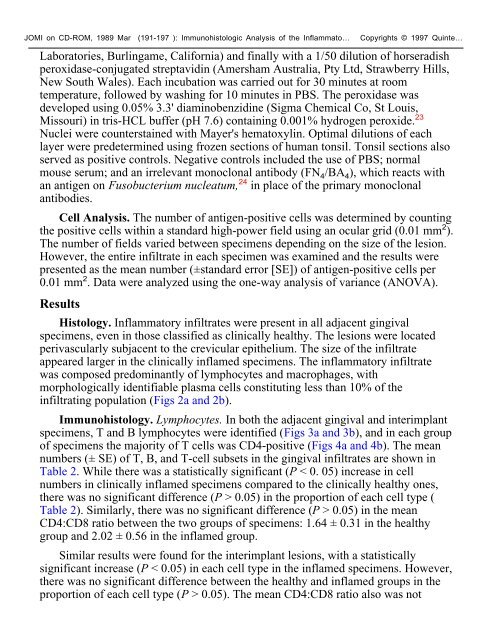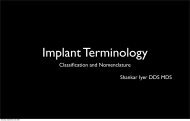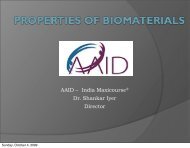Immunohistologic Analysis of the Inflammatory Infiltrates Associated ...
Immunohistologic Analysis of the Inflammatory Infiltrates Associated ...
Immunohistologic Analysis of the Inflammatory Infiltrates Associated ...
You also want an ePaper? Increase the reach of your titles
YUMPU automatically turns print PDFs into web optimized ePapers that Google loves.
JOMI on CD-ROM, 1989 Mar (191-197 ): <strong>Immunohistologic</strong> <strong>Analysis</strong> <strong>of</strong> <strong>the</strong> Inflammato…<br />
Copyrights © 1997 Quinte…<br />
Laboratories, Burlingame, California) and finally with a 1/50 dilution <strong>of</strong> horseradish<br />
peroxidase-conjugated streptavidin (Amersham Australia, Pty Ltd, Strawberry Hills,<br />
New South Wales). Each incubation was carried out for 30 minutes at room<br />
temperature, followed by washing for 10 minutes in PBS. The peroxidase was<br />
developed using 0.05% 3.3' diaminobenzidine (Sigma Chemical Co, St Louis,<br />
Missouri) in tris-HCL buffer (pH 7.6) containing 0.001% hydrogen peroxide.23<br />
Nuclei were counterstained with Mayer's hematoxylin. Optimal dilutions <strong>of</strong> each<br />
layer were predetermined using frozen sections <strong>of</strong> human tonsil. Tonsil sections also<br />
served as positive controls. Negative controls included <strong>the</strong> use <strong>of</strong> PBS; normal<br />
mouse serum; and an irrelevant monoclonal antibody (FN4/BA4), which reacts with<br />
an antigen on Fusobucterium nucleatum,24 in place <strong>of</strong> <strong>the</strong> primary monoclonal<br />
antibodies.<br />
Cell <strong>Analysis</strong>. The number <strong>of</strong> antigen-positive cells was determined by counting<br />
<strong>the</strong> positive cells within a standard high-power field using an ocular grid (0.01 mm2).<br />
The number <strong>of</strong> fields varied between specimens depending on <strong>the</strong> size <strong>of</strong> <strong>the</strong> lesion.<br />
However, <strong>the</strong> entire infiltrate in each specimen was examined and <strong>the</strong> results were<br />
presented as <strong>the</strong> mean number (±standard error [SE]) <strong>of</strong> antigen-positive cells per<br />
0.01 mm2. Data were analyzed using <strong>the</strong> one-way analysis <strong>of</strong> variance (ANOVA).<br />
Results<br />
Histology. <strong>Inflammatory</strong> infiltrates were present in all adjacent gingival<br />
specimens, even in those classified as clinically healthy. The lesions were located<br />
perivascularly subjacent to <strong>the</strong> crevicular epi<strong>the</strong>lium. The size <strong>of</strong> <strong>the</strong> infiltrate<br />
appeared larger in <strong>the</strong> clinically inflamed specimens. The inflammatory infiltrate<br />
was composed predominantly <strong>of</strong> lymphocytes and macrophages, with<br />
morphologically identifiable plasma cells constituting less than 10% <strong>of</strong> <strong>the</strong><br />
infiltrating population (Figs 2a and 2b).<br />
Immunohistology. Lymphocytes. In both <strong>the</strong> adjacent gingival and interimplant<br />
specimens, T and B lymphocytes were identified (Figs 3a and 3b), and in each group<br />
<strong>of</strong> specimens <strong>the</strong> majority <strong>of</strong> T cells was CD4-positive (Figs 4a and 4b). The mean<br />
numbers (± SE) <strong>of</strong> T, B, and T-cell subsets in <strong>the</strong> gingival infiltrates are shown in<br />
Table 2. While <strong>the</strong>re was a statistically significant (P < 0. 05) increase in cell<br />
numbers in clinically inflamed specimens compared to <strong>the</strong> clinically healthy ones,<br />
<strong>the</strong>re was no significant difference (P > 0.05) in <strong>the</strong> proportion <strong>of</strong> each cell type (<br />
Table 2). Similarly, <strong>the</strong>re was no significant difference (P > 0.05) in <strong>the</strong> mean<br />
CD4:CD8 ratio between <strong>the</strong> two groups <strong>of</strong> specimens: 1.64 ± 0.31 in <strong>the</strong> healthy<br />
group and 2.02 ± 0.56 in <strong>the</strong> inflamed group.<br />
Similar results were found for <strong>the</strong> interimplant lesions, with a statistically<br />
significant increase (P < 0.05) in each cell type in <strong>the</strong> inflamed specimens. However,<br />
<strong>the</strong>re was no significant difference between <strong>the</strong> healthy and inflamed groups in <strong>the</strong><br />
proportion <strong>of</strong> each cell type (P > 0.05). The mean CD4:CD8 ratio also was not




